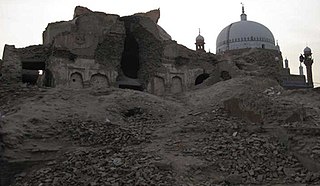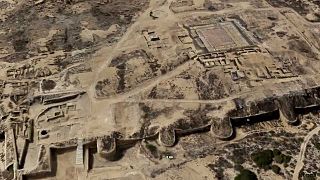
The London Wall is a defensive wall first built by the Romans around the strategically important port town of Londinium in c. AD 200, as well as the name of a modern street in the City of London, England.

Multan is a city in Punjab, Pakistan, located on the bank of river Chenab. It is one of the five largest urban centres of Pakistan in 2024 and serves as the administrative centre of Multan Division. A major cultural, religious and economic centre of Punjab region, Multan is one of the oldest inhabited cities of Asia, with a history stretching deep into antiquity.

The Lahore Fort is a citadel in the city of Lahore in Punjab, Pakistan. The fortress is located at the northern end of the Walled City of Lahore and spreads over an area greater than 20 hectares. It contains 21 notable monuments, some of which date to the era of Emperor Akbar. The Lahore Fort is notable for having been almost entirely rebuilt in the 17th century, when the Mughal Empire was at the height of its splendor and opulence.

Rohtas Fort is a 16th-century fortress located near the city of Dina in Jhelum district of the Punjab province of Pakistan. Raja Todar Mal, the minister of the Sur king Sher Shah Suri, supervised the construction of the fort which is now one of the largest and most formidable in Punjab.

Gingee Fort or Senji Fort in Tamil Nadu, India is one of the surviving forts in Tamil Nadu, India. It lies in Villupuram District, 160 kilometres (99 mi) from the state capital, Chennai, and is close to the Union Territory of Puducherry. The site is so fortified that Shivaji, the Maratha king, ranked it as the "most impregnable fortress in India", and it was called the "Troy of the East" by the British. The nearest town with a railway station is Tindivanam and the nearest airport is Chennai (Madras), located 150 kilometres (93 mi) away.

Champaner-Pavagadh Archaeological Park, a UNESCO World Heritage Site, is located in Panchmahal district in Gujarat, India. It is located around the historical city of Champaner, a city which was founded by Vanraj Chavda, the most prominent king of the Chavda Dynasty, in the eighth century. He named it after the name of his friend and general Champa, also known later as Champaraj. The heritage site is studded with forts with bastions starting from the hills of Pavagadh, and extending into the city of Champaner. The park's landscape includes archaeological, historic and living cultural heritage monuments such as chalcolithic sites, a hill fortress of an early Hindu capital, and remains of the 16th-century capital of the state of Gujarat. There are palaces, entrance gates and arches, mosques, tombs and temples, residential complexes, agricultural structures and water installations such as stepwells and tanks, dating from the eighth to the 14th centuries. The Kalika Mata Temple, located on top of the 800 metres (2,600 ft) high Pavagadh Hill, is an important Hindu shrine in the region, attracting large numbers of pilgrims throughout the year.

Tulamba is a small town in Punjab, Pakistan. Tulamba is situated on the eastern edge of the Ravi River, between the cities of Abdul Hakeem and Mian Channu. Prior to 1985 Tulamba belonged to the district of Multan, but in 1985 it was included within Mian Channu Tehsil in the newly formed Khanewal District. Tulamba's population is nearly 50,000. The spoken language is Rachnavi Punjabi. A native of Tulamba is referred to as a Tulmabvi.
The city of Multan, Punjab, Pakistan has many mausoleums and shrines, due to its rich heritage of pirs and saints. Some of the best-known mausoleums that can still be visited today include the following.
Pakistani architecture is intertwined with the architecture of the broader Indian subcontinent. The major architectural styles popular in the past were Temple, Indo-Islamic, Mughal and Indo-Saracenic architecture, all of which have many regional varieties. With the beginning of the Indus civilization around the middle of the 3rd millennium BC, for the first time in the area which encompasses today's Pakistan an advanced urban culture developed with large structural facilities, some of which survive to this day. This was followed by the Gandhara style of Buddhist architecture that borrowed elements from Ancient Greece. These remnants are visible in the Gandhara capital of Taxila.

The Shri Swami Narayan Mandir, Karachi is a Hindu temple that is the only Swami Narayan temple in Pakistan. The temple is notable for its size and frontage, over 32,306 square yards (27,012 m2) on the M. A. Jinnah Road in Karachi city. The temple celebrated its anniversary of 216 years in April 2004. There is a sacred cowshed within the premises of this temple. The temple is located at the centre of a Hindu neighbourhood in Karachi. The building that housed a dharmshala for visiting devotees has now been converted to the office of the City District Government.

The Bijapur Fort is located in the Bijapur city in Bijapur District of the Indian state of Karnataka. Bijapur fort has a plethora of historical monuments of architectural importance built during the rule of Adil Shahi dynasty.

Shri Varun Dev Mandir is a Hindu temple located in Manora Island in Karachi, Sindh, Pakistan. The temple is devoted to Lord Jhulelal (Varuna), the deity that represents water in Hinduism.

Prahladpuri Temple is a Hindu temple located in Multan city of Punjab province in Pakistan, adjacent to the Shrine of Bahauddin Zakariya. Named after Prahlada, it is dedicated to the Hindu deity Narasimha. In 1992, following the Demolition of the Babri Masjid in India, the temple was razed to ruin in a retaliatory act of violence by a Muslim mob. The site is currently owned by Evacuee Trust Property Board.
The Sun Temple of Multan was a temple dedicated to Surya, the Hindu Sun God, in the city of Multan in modern Pakistan. The location of the temple remains unknown; it is distinct from the Prahladpuri Temple.

Banbhore, Bambhore, Bhanbhore or Bhambhore is a city dating to the 1st century BCE located in modern-day Sindh, Pakistan. The city ruins lie on the N-5 National Highway, east of Karachi. It dates back to the Scytho-Parthian era and was later controlled by Muslims from the 8th to the 13th century, after which it was abandoned. Remains of one of the earliest known mosques in the region dating back to 727 AD are still preserved in the city. In 2004, Department of Archaeology and Museums Pakistan submitted the site for UNESCO World Heritage Sites.

There are eleven different types of buildings at the UNESCO-protected Champaner-Pavagadh Archaeological Park in Gujarat, India, including mosques, temples, granaries, tombs, wells, walls, and terraces. The monuments are situated at the foot of and around the Pavagadh Hill. The Baroda Heritage Trust lists 114 monuments in the area, of which only 39 are maintained by the Archaeological Survey of India, due to limited funding. The Forest Department owns 94% of the land here, while the temple trusts and other sectarian establishments provide facilities for boarding and lodging to pilgrims and tourists. On the southern side near the foot of the hill some dilapidated houses and the foundations of Jain temples can also be seen.

The Shrine of Bahauddin Zakariya is a 13th-century shrine located in the city of Multan, in Pakistan's Punjab province. The tomb is dedicated to the Muslim mystic Bahauddin Zakariya, founder of the Suhrawardiyya order of Sufism. It considered to be one of the most important shrines in southern Punjab province, and is the prototype for Multan's distinct architectural style.

















